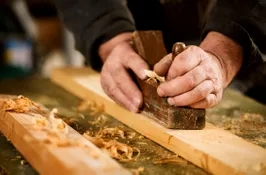In the world of carpentry and woodworking, hand planes are an essential tool that has been used for centuries. Hand planes are used to smooth and shape wood, and they are versatile enough to be used for a variety of different woodworking projects. From creating a perfectly flat surface to shaping intricate designs, a hand plane can do it all.

What is a Hand Plane?
A hand plane is a carpentry woodworking tool that is used to shave thin, uniform layers of wood from a workpiece. It is made up of a blade, also known as an iron, that is held in place by a wedge. The blade protrudes from the bottom of the plane, and when the plane is pushed across the surface of the wood, the blade shaves off a thin layer of wood, leaving a smooth surface behind.
There are many different types of hand planes, each with its own unique purpose. The most common types of hand planes are bench planes, which are used for flattening and smoothing large surfaces, and block planes, which are smaller and are used for trimming and shaping small pieces of wood.

Why Use a Hand Plane?
There are several benefits to using a hand plane in your woodworking projects. Firstly, hand planes are incredibly versatile, and can be used for a wide range of different tasks, from smoothing rough lumber to shaping intricate details. They are also relatively easy to use once you have mastered the technique, and require no electricity or batteries to operate, making them a great tool for working in remote locations or on the go.
Using a hand plane can also help you achieve a higher level of precision and accuracy in your woodworking projects. By shaving off thin, uniform layers of wood, you can create a perfectly flat and smooth surface, which is essential for many woodworking projects. Hand planes can also be used to create intricate details and shapes that are difficult to achieve with power tools.

How to Use a Hand Plane
Using a hand plane takes practice and patience, but with a little bit of time and effort, anyone can master the technique. The first step is to prepare your workpiece by making sure it is flat and free from any major imperfections. Then, select the appropriate hand plane for the task at hand, and adjust the blade to the desired depth.
To use the hand plane, hold it with both hands, with one hand on the front knob and the other on the back handle. Place the blade on the surface of the wood, with the bevel facing down, and push the plane forward in a smooth motion, applying gentle downward pressure. As you move the plane across the surface of the wood, you should be able to feel the blade shaving off thin layers of wood.
Conclusion
Hand planes are an essential tool for any woodworker, whether you are a beginner or an experienced craftsman. They are versatile, precise, and require no electricity to operate, making them a great addition to any workshop. If you are looking to take your woodworking to the next level, consider adding a hand plane to your toolkit. With a little bit of practice and patience, you can achieve amazing results with this essential carpentry woodworking tool.
